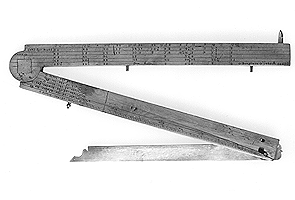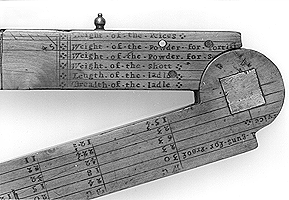 Fig. 15
Fig. 15  Fig. 16
Fig. 16
Signed: Bengamin Jobson 1680
Wooden folding rules were familiar craft instruments in 17th-century England. Although most commonly meant for carpenters, the Jobson example suggests that gunners also profited from the flexibility of this format. The rule incorporates two artillery tables, the first of which includes abbreviations for many of the same named artillery pieces as appeared on catalogue no. 2. However, it also includes newer types of artillery rated only by the weight of their shot (3, 6, 8, 12, 16 and 24-pounders). Unlike the earlier English instrument, the artillery table on the Jobson rule is complete, with figures provided for the weight of shot and the dimensions of ladles appropriate to different artillery pieces. The weight of powder required for both ordinary use ('service') and the larger amount needed for preliminary testing ('proof') is also tabulated. Further help for the gunner is supplied on the reverse of the instrument with a table relating the size of iron cannon balls to their weight, ranging from 1 to 8 inches diameter.
In addition to its useful tables, the folding rule also carries a scale of inches, a double logarithmic line of numbers for calculation with dividers, and a quadrant scale. To use the instrument as a quadrant, the thin brass arm is set at 90° to the wooden legs. With a plumbline hung from the tip of the arm, readings are taken against the degree scale on the supporting wooden arm.
Length (closed): 240 mm
Inventory no. 37,620